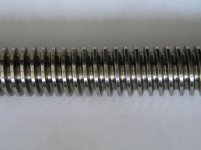Although I fully realize that the Radial pin design came directly from the ball screws commonly used in today's automated equipment, I find it hard to make comparisons between those actual ball screws and the Radial pin used in pool cues.
The one real difference that separates them is the fact that the ball nut is absent with the use of the Radial pin. Let's face it, the ball nut and ball screw work as a team to provide the very low friction, high load capacity, and zero backlash which is what makes them so good at what they do. The fact that the Radial pin, when used in a pool cue, does not have the ball nut changes everything. It now has friction all over the place so it can provide clamping force and have the friction to stay in place. A ball nut and screw could never do that because of the very low friction.
I have been privileged to have a good conversation about the Radial pin with Paul Costain, it's creator. I believe what he was after was a joint screw that would be easy for most cue makers to use and would give very good centering and alignment. The Radial fills that card completely. The female side is easy to make accurately with a tap, and the fit between the pin and the tapped hole has a tremendous amount of surface area and lines things up extremely well. Pretty much anyone with the simplest of equipment can successfully install them with great results.
The only issue I see with them is that they often come loose while playing. I believe this to be caused by poor face contact between the cue and the shaft. At least in the cases I've seen a simple facing of both sides fixes it right up. I think if he had gone with a shorter pitch (more threads per inch) this would be far less of an issue. But, then again, that would make the thread radius smaller which is the strong point of the Radial pin to start with.
Anyway, it's a good pin.
Royce Bunnell
www.obcues.com
